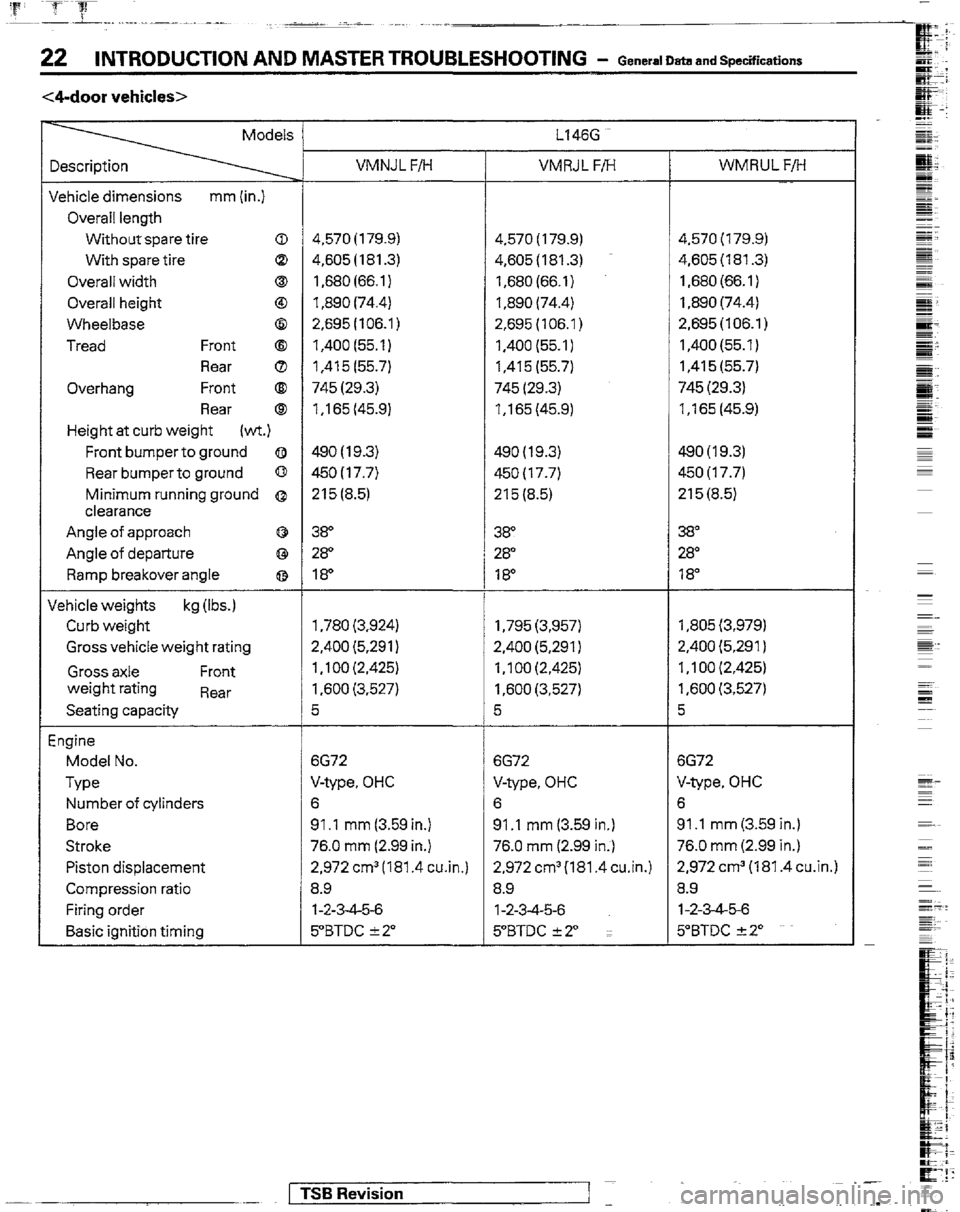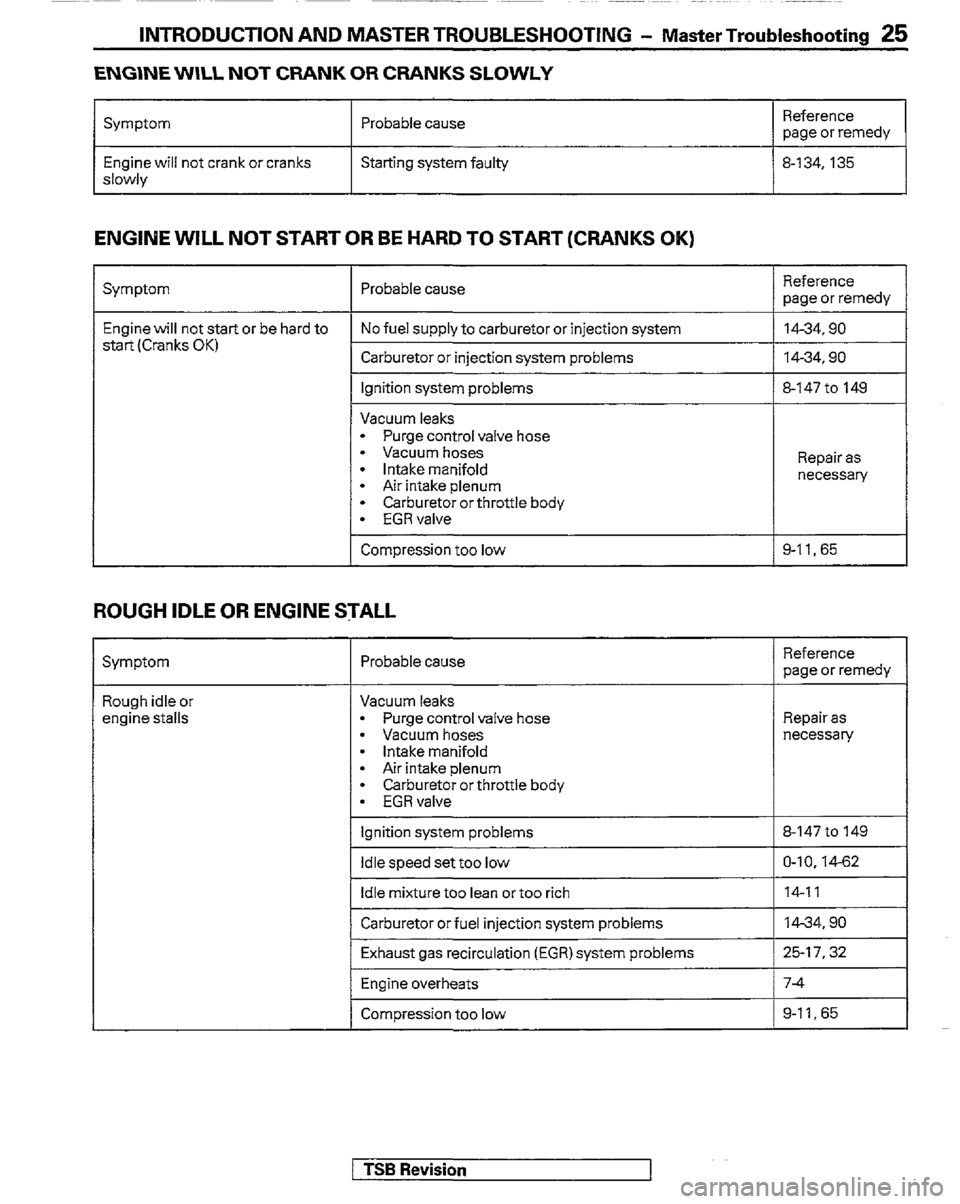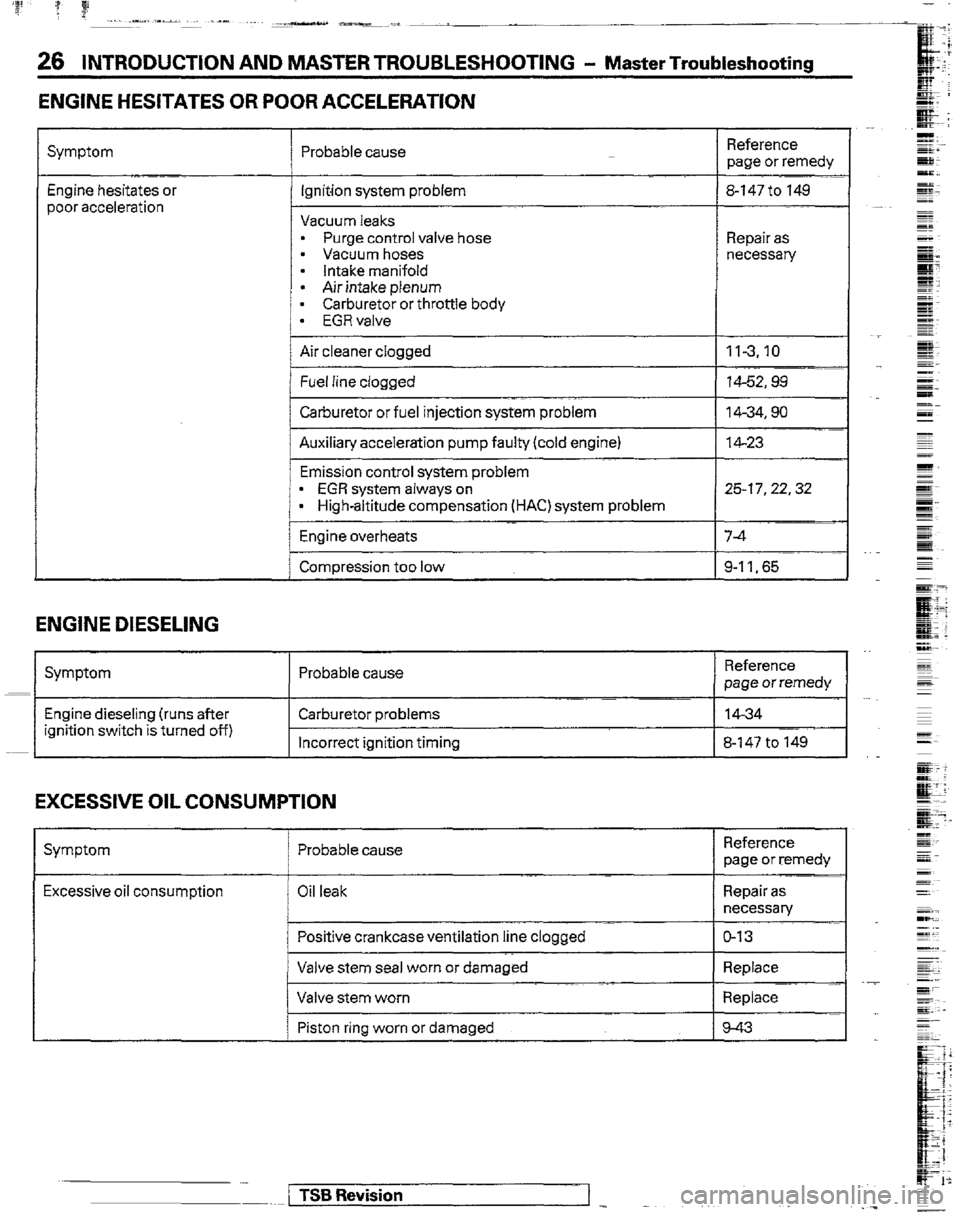ignition MITSUBISHI MONTERO 1989 1.G Workshop Manual
[x] Cancel search | Manufacturer: MITSUBISHI, Model Year: 1989, Model line: MONTERO, Model: MITSUBISHI MONTERO 1989 1.GPages: 30, PDF Size: 1.61 MB
Page 9 of 30

INTRODUCTION AND MASTER TROUBLESHOOTING - Precautions Before Service 9
nm (in.)
smo59
PARTS
When replacing parts, use MITSUBISHI genuine parts
VEHICLE WASHING
If high-pressure car-washing equipment or steam car-washing
equipment is used to wash the vehicle, be sure to maintain the
spray nozzle at a distance of at least 300 mm (11.8 in.) from
any plastic parts and all opening parts (doors, luggage
compartment, etc.).
SERVICING ELECTRICAL SYSTEM
1. Note the following before proceeding with work on the
electrical system.
Note that the following must never be done:
Unauthorized modifications of any electrical device or
wiring, because such modifications might lead to a vehicle
malfunction, over-capacity or short-circuit that could result
in a fire in the vehicle.
2. When servicing the electrical system, disconnect the
negative cable terminal from the battery.
Caution
1. Before connecting or disconnecting the negative
cable, be sure to turn off the ignition switch and the
fighting switch.
(If this is not done, there is the possibility of
semiconductor parts being damaged.)
2. After completion of the work steps [when the
battery’s negative (-) terminal is connected], warm
up the engine and allow it to idle for approximately
five minutes under the conditions described below,
in order to stabilize engine control conditions, and
then check to be sure that the idling is satisfactory.
For 3.OL Engine models: If the engine rpm is high,
switch OFF the ignition switch, and then, after
switching it ON again, let the engine idle for 2 or 3
minutes.
This will cause the engine rpm to decrease about
100 rpm, so repeat this procedure until the pre-
scribed idling speed is reached.
Engine coolant temperature : 85”-95°C (‘l85403”F)
Lights, accessories : OFF
Transmission : neutral position
(Automatic transmission models: “IV or “P”J
Steering wheel : neutral (center) position
1 TSB Revision
Page 21 of 30

INTRODUCTION AND MASTERTROUBLESHOOTING - GeneralDataandSpecmcations 21
L042G L141G
TNSL FM TNJL F/H
TRJL F/H TRUL F/H
Engine
Model No. G54B 6672 6672 6672
Type In-line OHC V-type, OHC V-type, OHC
V-type, OHC
Number of cylinders 4 6 6 6
Bore 91.1 mm(3.59in.j 91.1 mm(3.59in.j 91.1 mm(3.59in.) 91.1 mm(3.59in.
Stroke 98.0 mm (3.86 in.) 76.0 mm (2.99 in.) 76.0 mm (2.99 in.) 76.0 mm (2.99 in.
Piston displacement 2,555 cm3 2,972 cm3 2,972 cm3 2,972 cm3
(155.9 cuin.) (181.4cu.in.) (181.4cu.in.) (181.4 cuin.)
Compression ratio 8.7 8.9 8.9 8.9
Firing order 1-3-4-2 1-2-3-4-5-6 I -2-345-5 1-2-3-4.5-8
Basic ignition timing 7”BTDC 22” 5”BTDC 22” 5”BTDC i 2” 5”BTDC +-2”
Transmission &transfer case
Model No. KM145 V5MTl KM148 KM148
Type S-speed manual 5-speed manual &peed automatic &peed automatic
Gear ratio
Transmission 1st 3.967 3.918 2.826 2.826
2nd 2.136 2.261 1.493 1.493
3rd 1.360 1.395 1 .ooo 1.000
4th 1 .ooo 1.000 0.688 0.688
5th 0.856 0.829 -
Reverse 3.587 3.925 2.703 2.703
Transfer case High 1 .ooo 1 .ooo 1 .ooo 1 .ooo
Low 1.944 1.925 1.925 1.925
Final ring ratio gear 4.625 4.625 4.625 4.625
Clutch
Type Dry single disc & Dry single disc & -
diaphragm spring diaphragm spring
Chassis
Tire size
Front suspension
Type
Rear suspension
Type
Brakes
Type Front
Rear P225ff 5Rl5 P235ff5Rl5
independent Independent double-wishbone
double-wishbone
Rigid axle Rigid axle
Disc Disc
Drum Drum (Leading and trailing)
(Leading and trailing)
Power steering
Gear type
Gear ratio
Fuel tank capacity Integral type Integral type (Recirculating ball nut)
(Recirculating ball nut)
16.4 16.4
liters (gals.) 60 (15.9) 75 (19.8)
[ TSB Revision
Page 22 of 30

-_-
22 INTRODUCTION AND MASTER TROUBLESHOOTING - General Data and Specifications
<&door vehicles>
L-
chicle dimensions mm (in.)
Overall length
Withoutspare tire a
With spare tire @
Overall width 0
Overall height @
Wheelbase Q
Tread Front @
Rear 8
Overhang Front @
Rear @
Height at curb weight
Wt.)
Front bumperto ground @
Rear bumper to ground 0
Minimum running ground @
clearance
Angle of approach 8
Angle of departure
8
Ramp breakover angle
63
,hicle weights kg (Ibs.)
Curb weight
Gross vehicle weight rating
Gross axle Front
weight rating
Rear
Seating capacity
gine
Model No.
Type
Number of cylinders
Bore
Stroke
Piston displacement
Compression ratio
Firing order
Basic ignition timing VMNJL F/H VMRJL F/H
4,570 (179.9)
4,605 (181.3)
1,680 (66.1)
1,890 (74.4)
2,695 (106.1)
1,400 (55.1)
I,41 5 (55.7)
745 (29.3)
1 ,I 65 (45.9) 4,570 ( 179.9)
4,605(181.3)
1,680 (66.1)
1,890 (74.4)
2,695(106.1)
1.400(55.1)
1,415 (55.7)
745 (29.3)
1,165(45.9)
490 (19.3)
450(17.7)
215 (8.5) 490 (19.3)
450(17.7)
215 (8.5)
38”
28”
18” 38”
28
18”
-i
1,780 (3,924)
2,400 (5,291)
1,100(2,425)
1,600 (3,527)
5 1,795 (3,957)
2,400 (5,291)
1,100(2.425)
1,600 (3,527)
5
6672
V-type, OHC
6
91 .I mm (3.59 in.)
76.0 mm (2.99 in.)
2,972 cm3 (181.4 cu.in.)
8.9
l-2-3-4-5-6
5”BTDC i2” 6672
V-type, OHC
6
91 .l mm (3.59 in.)
76.0 mm (2.99 in.)
2,972 cm3 (181.4 cuin.)
8.9
1-2-3-4-5-6
5”BTDC 22” : L146G
L
_-. 1 TSB Revision I
.- WMRUL F/H
4.570 (179.9)
4,605 (181.3)
1,680 (66.1)
1,890 (74.4)
2,695(106.1)
1,400(55.1)
1,415 (55.7)
745 (29.3)
1,165 (45.9)
490 (19.3)
450 (17.7)
215 (8.5)
38”
28”
18
1,805 (3,979)
2,400 (5,291)
1 ,100 (2,425)
1,600 (3,527)
5
3072
V-type, OHC
3
31 .l mm (3.59 in.)
76.0 mm (2.99 in.)
2,972 cm3 (181.4 cu.in.)
3.9
l-2-3-4-5-6
5”BTDC 22”
Page 24 of 30

24 INTRODUCTION AND MASTER TROUBLESHOOTING - WasterTroubleshooting Tightening Torque I
TIGHTENING TORQUE
Description
Thread for general purposes
(size x pitch) mm
6x1.0
8x 1.25
10x1.25
12x 1.25
14x 1.5
16x 1.5
18x 1.5
20x1.5
22x 1.5
24x 1.5
Description
Taper thread for pipes (size)
PT1/8
PT l/4
PT 3B
Taper thread for dry sealed pipes (size)
NF’TF l/16
NPTF l/8
NPTF l/4 Head mark f
Nm
3.0-3-s
7.9-12
16-23
29-43
46-70
67-l 00
100-150
150-190
ZOO-260
269-320 ft.lbs.
2.2-2.9 4.9-7.8
3.6-5.8
5.8-8.7 13-19 9.4-14
12-17 27-39 20-29
2’132 47-72 35-53
35-52 77-110 57-35
51-77 130-160 SO-120
74-110 180-230 130-170
110-140 160-320 1 go-240
150-190 340-430 250-320
1 go-240 420-550 310-410 Head mark [
Nm I
ft.lbs.
Nm ftlbs. Remarks
7.9-I 2 5.9-9.7 Internal thread: Aluminum
76-19 12-14 Internal thread: Cast iron
19-30 14-22 Internal thread: Aluminum
34-45 25-33 Internal thread: Cast iron
39-54 29-40 Internal thread: Aluminum
58-73 43-54 Internal thread: Cast iron
4.9-7.8 3.6-5.8 Internal thread: Aluminum
7.9-12 5.8-8.7 Internal thread: Cast iron
7.9-12 5.8-8.7 Internal thread: Aluminum
16-1s 12-14 Internal thread: Cast iron
19-13 14-22 Internal thread: Aluminum
34-45 25-33 Internal thread: Cast iron
MASTER TROUBLESHOOTING NceKAAO
ENGINE OVERHEATS
Symptom Probable cause -
Reference
page or remedy
Engine overheats Cooling system faulty
Incorrect ignition timing
1 TSB Revision
Page 25 of 30

INTRODUCTION AND MASTER TROUBLESHOOTING - Master Troubleshooting 25
ENGINE WILL NOT CRANK OR CRANKS SLOWLY
Symptom
Engine will not crank or cranks
slowly Probable cause
Starting system faulty Reference
page or remedy
8-134.135
ENGINE WILL NOT START OR BE HARD TO START (CRANKS OK)
Symptom
Engine will not start or be hard to
start(Cranks OK)
ROUGH IDLE OR ENGINE STALL
Probable cause
No fuel supply to carburetor or injection system
Carburetor or injection system problems
Ignition system problems
Vacuum leaks
- Purge control valve hose
- Vacuum hoses
l intake manifold
- Air intake plenum
l Carburetor or throttle body
l EGRvalve
Compression too low Reference
page or remedy
14-34,90
14-34,90
3-147 to 149
Repair as
necessary
3-11.65
Symptom Probable cause Reference
page or remedy
Rough idle or
engine stalls Vacuum leaks
l Purge control valve hose
l Vacuum hoses
l Intake manifold
l Air intake plenum
l Carburetor or throttle body
l EGRvalve
1 Ignition system problems Repair as
necessary
8-147 to 149
Idle speed set too low 1 O-10.14-62
1~ ~ . Idle mrxture too lean or too rich 14-11
Carburetor or fuel injection system problems
Exhaust gas recirculation (EGR) system problems m-34.90
25-17.32
Engine overheats 7-4
Compression too low 9-11, 65
1 TSB Revision
Page 26 of 30

‘p ? f! .., .-, _-_ ,_- ____ ____ _L(
26 INTRODUCTION AND MASTER TROUBLESHOOTlNG - Master Troubleshooting
ENGINE HESITATES OR POOR ACCELERATION
Symptom Probable cause
Engine hesitates or
poor acceleration
-I
Ignition system problem
Vacuum leaks
l Purge control valve hose
l Vacuum hoses
- intake manifold
l Air intake plenum
* Carburetor or throttle body
l EGRvalve
ENGINE DIESELING
Reference
page or remedy
8-147 to 149
Repair as
necessary
Air cleaner clogged
Fuel line clogged 113.10
1442.99
Carburetor or fuel injection system problem
Auxiliary acceleration pump faulty (cold engine)
Emission control system problem
l EGR system always on
- High-altitude compensation (HAC) system problem
Engine overheats 14-34.90
14-23
25-77.22.32
7-4
Compression too low g-II.65
I Symptom Probable cause I
Reference
page or remedy
I I I I -..
Engine dieseling (runs after
ignition switch is turned off) Carburetor problems
Incorrect ignition timing 14-34
8-14710 149
EXCESSIVE OIL CONSUMPTION
Symptom Probable cause Reference
page or remedy
Excessive oil consumption Oil leak
Positive crankcaseventilation line clogged
Valve stem seal worn or damaged
Valve stem worn
Piston ring worn or damaged Repair as
necessary
o-13
Replace
Replace
9-43
1 TSB Revision
Page 27 of 30

INTRODUCTION AND MASTER TROUBLESHOOTING - Master Troubleshooting 27
POOR FUEL MILEAGE
Symptom Probable cause Reference
page or remedy
Poor fuel mileage Fuel leak Repair as
necessary
I
1 Air cleaner clogged
1 Ignition problems 1 11-3.10 1
1 8-147to 149 1
Carburetor or fuel injection system problems 1434.90
I
Compression too low
1 g-II.65 1
Tires improperly inflated 1 22-2
I
Clutch slips
16-4 I
Brakes drag 1 5-13 I
NOISE
Probable cause Reference
page or remedy
Noise Loose bolts and nuts Retighten as
necessary
I
1 Enaine noise
I 9-11 I
HARD STEERING
Symptom
Hard steering Probable cause
Loose power steering oil pump belt
Low fluid level
Air in power steering system
Low tire pressure
Excessive turning resistance of upper or lower ball joint
Excessivelytight linkage ball joint
Improperfrontwheel alignment
Excessive turning resistance of tie-rod ball joint
No lubricantion of tie-rod
Sticky flow control valve
No lubrication of idler arm Reference
page or remedy
19-10
19-11
19-11
22-2
2-27
1937
2-13
19-38 ’
Lubricate
19-33
19-39
) TSB Revision